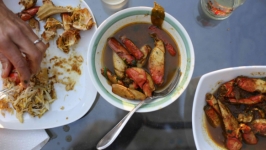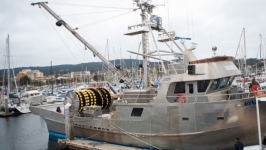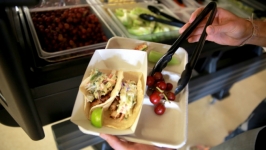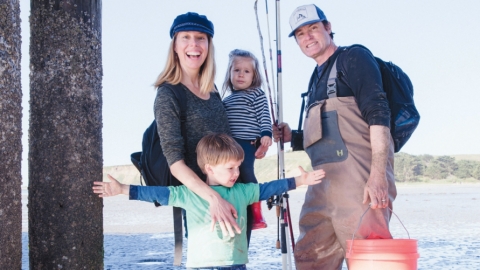Beginner's Guide To Dungeness Crabbing in Pacifica
On a brisk morning, my dad and I headed down to the Pacifica Pier (at 2100 Beach Blvd.) to try our hand at crabbing for the first time. The pier wasn’t crowded when we arrived but quickly filled up with many groups of friends and families. Most people set up for the long haul to enjoy a day by the water and go home with dinner. In the midst of seasoned crabbers were quite a few newbies such as myself and many of the experts readily shared their techniques.
Equipment
The previous day, we had stopped by Hi’s Tackle Box (40 Chestnut Ave. in South San Francisco) to stock up on crabbing tackle. We followed the helpful advice and left with a mesh hoop, a metal bait box, a crab measure and bait. The metal bait box was not a necessary purchase but came in handy as we watched crabs eat right through other people’s mesh hoops. We used zip ties to secure the metal bait box to the mesh hoop. We also picked up a free tide chart booklet at the fishing store. The best time to go crabbing is on mornings with a low tide. Finally, don’t forget a bucket or cooler to store your catch throughout the day.
The Process
Crabbing is not very difficult—the only requirement is a little patience. After loading the bait into the bait box, simply drop the net into the water, holding onto the rope on the other end. Wait until the hoop reaches the bottom and then tie off the end of the rope to the pier. Once you’ve lowered your hoop, simply wait about 20 minutes for the crabs to discover your bait. While you wait, sit back and enjoy the scene.
Keep in mind not to drop the hoop too close to the pier pillars as it can easily get tangled, in which case you’d have to cut your outing short and abandon your gear to the ocean. However, if your hoop does get caught, don’t give up right away. This happened to my dad and me when we went and after a few minutes of finagling, we managed to get our hoop untangled.
Rules & Regulations
After about an hour, I pulled up my hoop for the third time and discovered that I had caught a crab. I pulled the hoop up all the way and carefully lifted the crab out. At this point, measuring the crab is very important. The rules and regulations for crabbing have changed this past year.
Here are a few guidelines to keep in mind:
• Licenses are not required and there are no fees. The City of Pacifica website details the rules on the pier. Fines can be very hefty so following the rules is advised.
• An important rule to remember is that Dungeness crabs caught must be at least 5 3⁄4 inches to keep, so a measuring tool is absolutely necessary and only costs a couple of bucks.
• There is a 10-crab limit per person and while there is no rule requiring recreational fishermen to throw the female crabs back in, most fishermen do it anyway, to keep the crabbing population healthy.
• The crabbing season ranges from the beginning of November through June.
Once You’ve Caught Your Crabs
The Pacifica Pier offers a station for cleaning your catch on the spot or you can keep your crabs in a bucket/cooler filled with water and clean them once you get home. While I was there, some people cleaned their crab at the pier. As a newbie, cleaning the crab at home once it’s already been cooked might be easier.
How Do You Cook a Dungeness Crab?
First boil the crab for about 7 minutes per pound in a covered pot and then rinse in cold water until the crab is cool enough for you to handle. Then break off the apron, which is between the back legs and carapace, the large shell of the crab. Rinse the crab again to remove all guts. Next remove the gills (from both sides of the body) and the mandible, which is the mouthpiece of the crab. Again, rinse to clean the guts. Finally, turn the crab upside down and break it in half.
The crabs are so fresh that you don’t need to add much to them. Simply serve with a lemon wedge or melted garlic butter. Add some bread or crackers and you have quite a meal.






